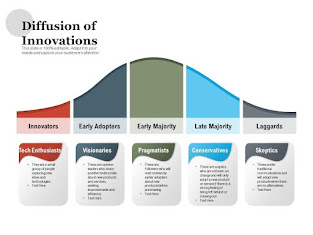Everett Rogers, a professor in rural psychology, coined the theory of Diffusion of Innovations. He explained this phenomenon, by stating that individuals living in a society will automatically fit into one of five categories. These categories are reflected by how early or how late individuals are willing to adopt or accept a new innovation.
The innovators are the very first people to adopt an innovation. These people are the creative risk-takers of the world and are responsible for introducing and spreading the innovation to others.
The early adopters follow, playing a key role in endorsing the innovation. They are responsible for closing the gap between the "trendsetters" and the larger majority.
Those within the early majority group, take their time making decisions and will only adopt a product once they are convinced of its benefits.
While the late majority are much more resistant to change. For individuals, in this category, an innovation or product must be well-tested and widely used before they even consider using it.
At the very bottom of this theory, we have the laggards, who are extremely resistant to change. These are the types of people who have minimal exposure to media and are very unaware of what is going on in terms of creation and advancement. In most cases, these laggards are aware but want nothing to do with this new change, so they refuse to adopt.
So what does this theory look like when applied to an actual innovation? Let's use the printing press as an example. From an obvious standpoint Bi Sheng, Wang Chen, and Johannes Gutenberg would be considered to be the primary innovators. They took a significant risk each on their own to develop multiple versions of a movable type of printing press. Innovators outside of them would have been those who experimented with ink and paper.
Some of the early adopters included university professors, reformers, entrepreneurs, and early printing houses. Professors and scholars were more than eager to get their hands on the press. They saw this as an opportunity to spread knowledge and education to those who did not have access beforehand. Martin Luther became the first best-selling author thanks to the printing press. Luther used the press as an opportunity to bring the Protestant faith to the frontline of Europe. He posted his '95 Theses' on the door of a church and within a few weeks it was being printed and shared all throughout Europe.
Business owners would recognize the monetary profit that they could receive if they invested in this creation. Printed materials could be used for advertising, record-keeping, and even communication, so owners would start to invest in pamphlets and books. Meanwhile, early printing houses took the biggest risk of all adopting this innovation right from the start. Printing house owners invested in the printing technology, and became eager to produce and sell a variety of texts.
The early majority were those who waited a little while before choosing to invest. These would mainly include middle-class citizens, libraries, and educational institutions. The printing press increased the literacy rates of individuals, so much of the middle class could now have access to and the opportunity to read and purchase books. Following the overwhelming increase in the public, libraries began to invest in printed works to not only enhance the reputation of the institution but to support the growth of education.
On the opposite side of the theory, we have those who were not as eager and who didn't see the overall greatness of the printing press. The late majority consisted of those who lived in areas where it was not really needed ie. farmers. Those living in isolated and rural areas thrived and lived off of word-by-mouth and handwritten texts. Religious organizations were also late to the game because they were worried that a mass spread of printed texts would spread a variety of radical ideas. They would later adopt it to help further and benefit their own religious beliefs.
At the very bottom, we have the laggards and those are the last to adopt, and in some cases never adopt. In the case of the printing press, the laggards could be considered those who had jobs as scribes, or copiers. They believed that their jobs and livelihoods were at risk, so they didn't support the idea in protest. Individuals living in super remote areas oftentimes hold onto culture and tradition, which leaves no room for advancement. One common laggard, that seems to follow every innovation is the older generation who seem to never have an interest in getting involved. Society is constantly changing, and very few hold onto tradition. So I admire those who have the confidence to stand their ground and show the rest of us, that while this new fancy innovation does make life easier to live, you don't need it. We all forget that we managed to live perfectly normal and successful lives without these things and we still can.







No comments:
Post a Comment